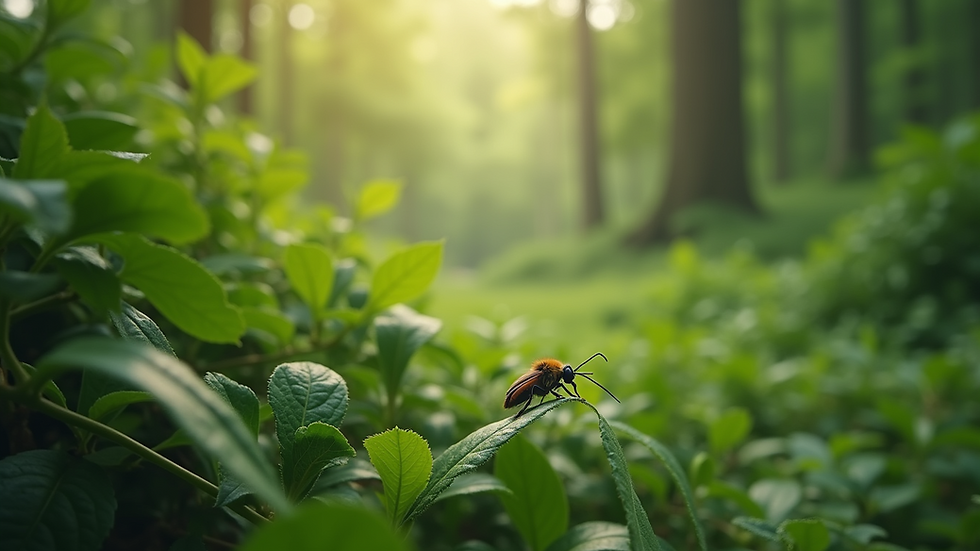Real-Time Insights into AI's Role in Transforming Insect Conservation Efforts in West Michigan
- Joel Scoby

- Aug 23
- 4 min read
The issue of insect conservation is more urgent than ever, particularly in regions like West Michigan. Recent studies show that insect populations worldwide have declined by about 75% since the 1980s, a crisis that threatens to disrupt ecosystems, agriculture, and biodiversity. This stark reality calls for innovative and effective solutions. Artificial intelligence (AI) is emerging as a game-changing tool in conservation efforts. This post examines how real-time insights from AI are not just enhancing but transforming insect conservation in West Michigan, offering a beacon of hope for ecological preservation.
The Importance of Insect Conservation
Insects are vital for ecological health. They pollinate about 75% of the world’s crops and wild plant species, contribute to decomposition, and serve as food for birds, mammals, and other wildlife. Despite their crucial roles, insects face numerous threats, including habitat destruction, climate change, and pesticide use, resulting in a significant decline in their populations. In West Michigan, studies indicate that populations of essential pollinators, such as honeybees, have dropped by 30% over the past decade. This decline jeopardizes local ecosystems and agricultural productivity.
Traditionally, conservation efforts relied on manual observations and data collection, processes that are labor-intensive and susceptible to errors. The integration of AI technologies offers a modern solution, streamlining the collection and analysis of vital data.
How AI is Transforming Data Collection
AI technologies, including machine learning and computer vision, are significantly improving how data on insects is collected. Researchers can deploy sensors and cameras in natural settings to gather real-time data about insect populations and behaviors.
For example, a study in West Michigan utilized AI algorithms to analyze over 50,000 images from automated cameras, accurately identifying 30 different species of beetles and tracking their movements throughout the seasons. This automated process not only saves time but also allows researchers to focus on the interpretation of the data and the formulation of effective conservation strategies.

Real-Time Monitoring and Analysis
One of the most notable advantages of AI in insect conservation is continuous, real-time monitoring of insect populations. Traditional research methods typically involve infrequent surveys, which can overlook sudden changes in populations. In contrast, AI enables ongoing monitoring that offers critical insights into how populations fluctuate in response to environmental changes.
For instance, researchers in West Michigan have successfully used AI to track the emergence of Monarch butterflies. By analyzing temperature and weather pattern data, AI helps predict when these butterflies will appear, allowing for timely conservation interventions, such as habitat restoration projects targeted at protecting their breeding grounds.
Enhancing Public Engagement and Education
AI is also contributing to increased public engagement in insect conservation efforts. Interactive platforms powered by AI can offer real-time visualizations of data, making it easier for community members to grasp the importance of protecting insects.
Local schools in West Michigan are utilizing educational programs that incorporate these AI technologies. Students can engage in hands-on activities, such as collecting data and analyzing results through user-friendly apps. This approach fosters a sense of stewardship, encouraging young people and families to participate in local conservation initiatives actively.
Predictive Analytics for Conservation Strategies
The predictive analytics capabilities of AI play a critical role in shaping effective conservation strategies. By analyzing both historical data and current trends, AI can help identify potential threats to insect populations and suggest proactive measures.
For example, if AI data analysis predicts an increased risk of decline in a specific bumblebee species due to habitat loss, conservationists can prioritize reforestation and habitat preservation efforts in those areas. A targeted approach like this is more effective and ensures resources are used where they are most needed, potentially reversing negative trends in insect populations.
Collaborations and Partnerships
Successful implementation of AI in insect conservation hinges on collaboration among various stakeholders, including scientists, conservation groups, and tech companies. In West Michigan, new partnerships are forming to leverage AI technology effectively.
For instance, a collaboration between a local university and a technology startup is leading to the development of a community-based app that allows residents to report their observations of insect populations. This grassroots data collection approach enhances knowledge sharing and resource pooling, leading to more comprehensive strategies for conservation efforts.
Challenges and Considerations
While the promise of AI in insect conservation is significant, various challenges must be addressed. Critical issues such as data privacy, ethical implications, and the need for robust technological infrastructure remain a concern.
Additionally, it is essential to acknowledge the importance of traditional conservation methods. An effective conservation strategy will likely integrate both AI-driven innovations and proven practices to achieve the best outcomes for insect populations.
Future Directions in Insect Conservation
The future of AI in insect conservation looks bright. As technology advances, we can expect improvements in algorithms geared toward more precise species identification, enhanced predictive models, and refined data collection methods.
Public awareness of insect conservation is on the rise, which may lead to increased funding and community resources dedicated to these efforts. By embracing AI technology, West Michigan has the potential to become a leader in innovative conservation strategies that ensure healthy ecosystems for future generations.
A Bright Future for Insect Conservation
The integration of AI in insect conservation in West Michigan marks a transformative step in the field. By enabling real-time insights and efficient data analysis, AI is reshaping how researchers and conservationists tackle the challenges posed to insect populations.
As we navigate this increasingly technological landscape, fostering partnerships and promoting a balanced approach between innovation and traditional methods will be vital. With the commitment of local communities and ongoing advancements in technology, the future of insect conservation in West Michigan is promising, paving the way for vibrant ecosystems and a sustainable environment.




Comments